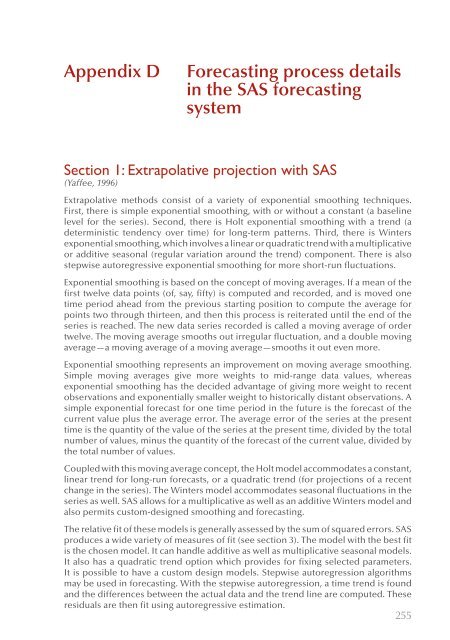PDF: 5191 KB - Bureau of Infrastructure, Transport and Regional ...
PDF: 5191 KB - Bureau of Infrastructure, Transport and Regional ...
PDF: 5191 KB - Bureau of Infrastructure, Transport and Regional ...
- No tags were found...
You also want an ePaper? Increase the reach of your titles
YUMPU automatically turns print PDFs into web optimized ePapers that Google loves.
Appendix DForecasting process detailsin the SAS forecastingsystemSection 1: Extrapolative projection with SAS(Yaffee, 1996)Extrapolative methods consist <strong>of</strong> a variety <strong>of</strong> exponential smoothing techniques.First, there is simple exponential smoothing, with or without a constant (a baselinelevel for the series). Second, there is Holt exponential smoothing with a trend (adeterministic tendency over time) for long-term patterns. Third, there is Wintersexponential smoothing, which involves a linear or quadratic trend with a multiplicativeor additive seasonal (regular variation around the trend) component. There is alsostepwise autoregressive exponential smoothing for more short-run fluctuations.Exponential smoothing is based on the concept <strong>of</strong> moving averages. If a mean <strong>of</strong> thefirst twelve data points (<strong>of</strong>, say, fifty) is computed <strong>and</strong> recorded, <strong>and</strong> is moved onetime period ahead from the previous starting position to compute the average forpoints two through thirteen, <strong>and</strong> then this process is reiterated until the end <strong>of</strong> theseries is reached. The new data series recorded is called a moving average <strong>of</strong> ordertwelve. The moving average smooths out irregular fluctuation, <strong>and</strong> a double movingaverage—a moving average <strong>of</strong> a moving average—smooths it out even more.Exponential smoothing represents an improvement on moving average smoothing.Simple moving averages give more weights to mid-range data values, whereasexponential smoothing has the decided advantage <strong>of</strong> giving more weight to recentobservations <strong>and</strong> exponentially smaller weight to historically distant observations. Asimple exponential forecast for one time period in the future is the forecast <strong>of</strong> thecurrent value plus the average error. The average error <strong>of</strong> the series at the presenttime is the quantity <strong>of</strong> the value <strong>of</strong> the series at the present time, divided by the totalnumber <strong>of</strong> values, minus the quantity <strong>of</strong> the forecast <strong>of</strong> the current value, divided bythe total number <strong>of</strong> values.Coupled with this moving average concept, the Holt model accommodates a constant,linear trend for long-run forecasts, or a quadratic trend (for projections <strong>of</strong> a recentchange in the series). The Winters model accommodates seasonal fluctuations in theseries as well. SAS allows for a multiplicative as well as an additive Winters model <strong>and</strong>also permits custom-designed smoothing <strong>and</strong> forecasting.The relative fit <strong>of</strong> these models is generally assessed by the sum <strong>of</strong> squared errors. SASproduces a wide variety <strong>of</strong> measures <strong>of</strong> fit (see section 3). The model with the best fitis the chosen model. It can h<strong>and</strong>le additive as well as multiplicative seasonal models.It also has a quadratic trend option which provides for fixing selected parameters.It is possible to have a custom design models. Stepwise autoregression algorithmsmay be used in forecasting. With the stepwise autoregression, a time trend is found<strong>and</strong> the differences between the actual data <strong>and</strong> the trend line are computed. Theseresiduals are then fit using autoregressive estimation.255
















